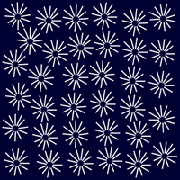[SPLENDIDMAGAZINE.COM]
PDA and mobile phone version
Post Date: 12/31/2005
 Effacement Cut Format Reviewed: CD |
In opener "Thermo", Korber begins with arguably the most minimal of motifs, a miniscule digital glitch. He adds a twin and then a triplet, but does it so lethargically that you might not notice that the CD is playing; he pits the elements against one another in a canonic fashion, while uniting the pinpoints and scratches into a thick, flowing rhythmic texture. Korber is stingy and patient with his materials, holding us in a trance with nervous tension -- like the anticipation of that last page in a book, where we finally learn the killer's motive -- and amazement at how much mileage he gets with such a limited sound set. He concedes near the six-minute mark, introducing a breathy, pulsing drone -- which sounds a bit like a marching band heard from a few miles away -- beneath the increasingly twitchy speckled swarm. Korber knows when you've had enough of this sameness, and abruptly hacks away the excess detail, riding a lilting vapor trail until niente for the last four of the piece's nineteen minutes.
Following such a spectacular work is difficult, but the composer does his best in "Wüste". What initially seems like a lull, at least compared to the previous sonorous labyrinth, soon turns into a hushed concentration of electrical hum; you may have to turn off your heat to hear it, as this collage of guitar feedback and low frequencies is set right on the threshold of human hearing (though you feel it in your stomach). In "Fred Austere", Korber exploits the electric guitarisms hinted at during the prior work. He leaves his cable halfway into the jack, messing with it for short intervals, then nervously tapping his buried-under-a-sea-of-electronics strings for a Gamelan-like effect (i.e. deep, monotonal metallic thumps).
The remaining three tracks follow suit: Korber circumvents and varies his palette, but constructs the works in the same formal fashion. He methodically molds a simple sine wave from meek to painful on "The Synaptic Spell", adding then peeling back harmonics and screeching AM radio static over the course of fourteen minutes. He explores a bit of melody via lugubrious post-rock guitar drones, Godspeed style, in "Too Thin a Skin". He summarizes the previous hour during the album's final few moments ("Que les jours s'en aillent") by mixing earlier clicks and beeps into a hospital-monitor rhythm, killing the body, exposing the beating heart for all to hear. Then there's a minute of silence -- which might sound a bit dramatic, but you haven't listened yet, have you?
In 1901, after witnessing a single performance of a Debussy piece (Pelleas et Melisand), one critic called the composer's music "vague, floating, without color and without shape, without movement and without life." However, Debussy's music is historically revered for its layers, simplistic sound forged from complex techniques and, as one author describes, a global approach of "quiet intensity". In other words, this work took a minute to label but years to understand. In the same manner, Korber's music might initially seem like a bunch of noisy, messed up CD skips and test tones, but an investment of sober concentration reveals bottomless textures, deft precision, OCD attention to microscopic detail and the composer's ability to animate the digital world. Stellar.
Splendid Web Media. All rights reserved.